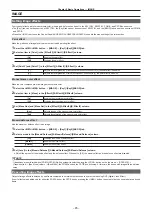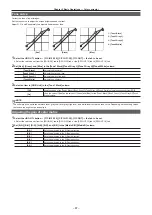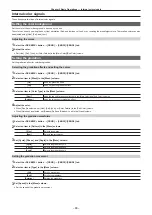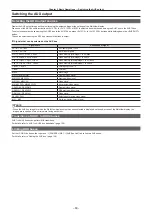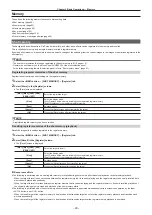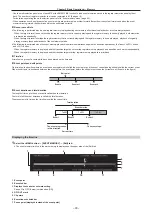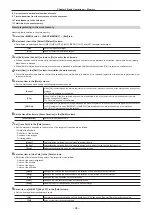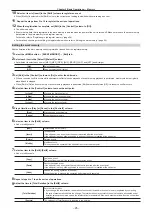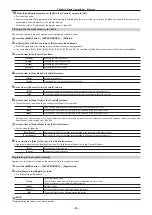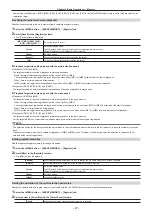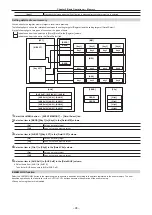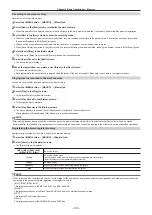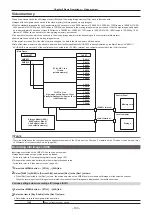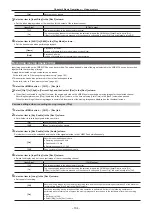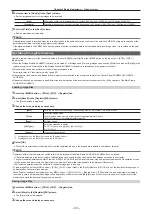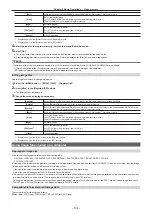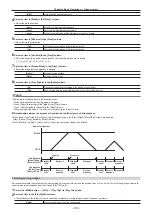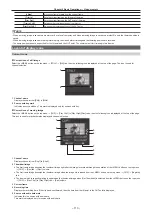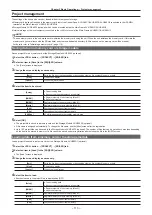
– 99 –
Chapter 5 Basic Operations — Memory
Amount of transition
PGM-A
PST-B
Event memory
Ex) Events 1 to 3
Event 1
Playback
Event 1
Playback
Event 1
Playback
Reverse
playback
Event 1 Event 2
Event 2
Event 2
Event 3
Event 3
Event 1
Event 1
Event 1
@
@
NOTE
t
The target to be played back by EMEM LINK is the background transition for ME (ME1 or ME2) which is controlled by the ME line to which the
corresponding <EMEM LINK> button belongs. KEY is not played back.
t
DSK, AUX, Clip, CBGD, and XPT are not played back with the EMEM LINK operation.
t
The register memory last played back for ME (ME1 or ME2) of the EMEM LINK target is played back with the fader lever.
The register memory can be changed in the multi-selection panel area before the fader lever operation. The register memory to be played back with
EMEM LINK lights in red in the multi-selection panel area.
t
When the register memory is ready for playback by the fader lever, the <EMEM LINK> button lights in the High tally color.
t
If the register memory cannot be played back by the fader lever, such as when the register memory to be played back is not selected, the <EMEM
LINK> button lights in the Low tally color.
t
The selection button for the background wipe preset menu in the multi-selection panel will move to top left (pattern 1) when event memory is played
back by EMEM LINK.
Macro memory
The macro memory is a function to record and play back a series of operations performed on the Control Panel AV-HS60C1/AV-HS60C2/AV-HS60C4
and Menu Panel AV-HS60C3.
It enables recording and playback of a more detailed range including functions which are not covered by the shot memory and the event memory (such
as input setting, output setting, and USK setting).
Recorded macros can be played by pressing the macro bus crosspoint buttons or a specific button where macro is attached.
@
@
NOTE
t
As many as 81 recorded macros (9 pages
×
9) can be registered in the register memory.
t
Each register memory of a macro has the capacity of 127 KB, and can store approximately 3000 steps of operations depending on the operation.
t
When an operation that takes time to process is recorded, next operation may not playback correctly. Insert a delay between the two operations as
necessary. For the procedure to insert a delay, refer to “Recording to the work memory” (page 100).
t
Macros may not be played back correctly after deleting and registering the plug-in software in the following case.
- When menu operation added by the plug-in software is recorded in the macro register memory
Record and register the operation again if necessary after deleting the applicable macro register memory.
t
Macros may not be played back correctly after updating the version of the software in the following case.
- When menu operation under the <SYS> button/<CONF> button on the top menu is recorded in the macro register memory
Record and register to the macro register memory again after performing the software version update for the applicable operation.
Status displays
The [MACRO] indicator at the top portion of the Menu Panel AV-HS60C3 lights in red during macro recording, lights in green during playback, and lights
in orange when playback is paused.
1
Select the <MEM> button
→
[MACRO]
→
[Macro] tab.
2
Check the [Status] column display.
[Rec]
[Rec] is displayed during macro recording.
This has a blank display except during macro recording.
[Play]
The name of the macro currently playing is displayed during macro playback.
This has a blank display except during macro playback.
[Pause]
The name of paused macro is displayed when the macro playback is paused.
The display other than when the macro playback is paused will be blank.
3
Check the [Work Status] column display.
[Current Event]
Displays the number of current events in the work memory.
[Total Event]
Displays the total number of events recorded in the work memory.
[Used]
Displays the usage of the work memory. (Unit: Byte)
[Remain]
Displays the remaining capacity of the work memory. (Unit: Byte)
Summary of Contents for AV-HS60C1E
Page 5: ...Please read this chapter and check the accessories before use Chapter 1 Overview ...
Page 52: ...This chapter describes menu operations Chapter 5 Basic Operations ...
Page 162: ...This chapter describes the difference with the Standard mode Chapter 9 3G mode 4K mode ...
Page 168: ...This chapter describes the terminals and signals of the unit Chapter 10 External Interfaces ...
Page 184: ...This chapter describes the setting menu table and terms Chapter 12 Appendix ...
Page 206: ...Web Site http www panasonic com Panasonic Corporation 2014 ...

